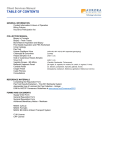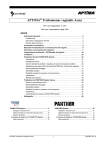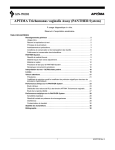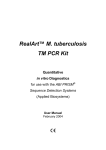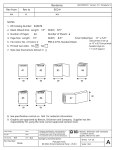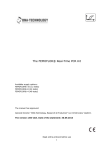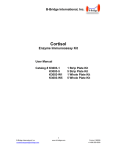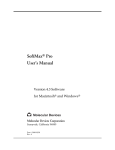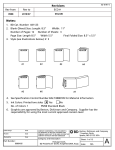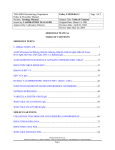Download the Package Insert
Transcript
Revisions Rev from Rev to ECO # 03 6608-12 02 BALTSO0191 Version 7.0 Template 4 NOTES: 1. BD Catalog Number: 441917 2. Blank (Sheet) Size: Length: 8.5” Width: 11” 3. Number of Pages: 24 Number of Sheets: 4. Page Size: Length: 8.5” Width: 5. Ink Colors: No. of Colors: 1 6. Printed two sides: Yes X 6 5.5” Final Folded Size: 5.5” x 8.5” PMS#: Standard Black No 7. Style (see illustrations below): # 5 W W W W W W W 8. See specification control no. BALT8089063 for material information. 9. Graphics are approved by Becton, Dickinson and Company. Supplier has the responsibility for using the most current approved revision level. Label Design Date Proofer Date Checked By Date Part Number: 8089063 COMPANY CONFIDENTAL. THIS DOCUMENT IS THE PROPERTY OF BECTON, DICKINSON AND COMPANY AND IS NOT TO BE USED OUTSIDE THE COMPANY WITHOUT WRITTEN PERMISSION. Category and Description Package Insert, TV Qx Amplified DNA Assay Becton, Dickinson and Company 7 Loveton Circle Sparks, MD 21152 USA Sheet: 1 of 25 Scale: N/A A x ProbeTec™ Trichomonas vaginalis (TV) Q Amplified DNA Assay English: pages 1 – 19 8089063(03) 2013-09 441917, 443433 Свържете се с местния представител на BD за инструкзии. / Kontaktiraj lokalnog predstavnika BD za upute. / Pokyny vám poskytne místní zástupce společnosti BD. / Kontakt den lokale BD repræsentant for at få instruktioner. / Neem contact op met uw plaatselijke BD-vertegenwoordiger voor instructies. / Kasutusjuhiste suhtes kontakteeruge oma kohaliku BD esindajaga. / Ota yhteys lähimpään BD:n edustajaan ohjeiden saamiseksi. / Επικοινωνήστε με τον τοπικό αντιπρόσωπο της BD για οδηγίες. / A használati utasítást kérje a BD helyi képviseletétől. / Нұсқаулар үшін жергілікті BD өкілімен хабарласыңыз. / Naudojimo instrukcijų teiraukitės vietos BD įgaliotojo atstovo. / Kontakt din lokale BD-representant for mer informasjon. / Aby uzyskać instrukcje użytkowania, skontaktuj się z lokalnym przedstawicielstwem BD. / Contacte o representante local da BD para instruções. / Pentru instrucţiuni, contactaţi reprezentantul local BD. / Для получения указаний обратитесь к местному представителю компании BD. / Obratite se svom lokalnom predstavniku kompanije BD za uputstva. / Inštrukcie získate u miestneho zástupcu spoločnosti BD. / Kontakta närmaste BD-representant för anvisningar. / Talimatlar için yerel BD temsilcinizle temasa geçin. INTENDED USE The BD ProbeTec™ Trichomonas vaginalis (TV) Qx Amplified DNA Assay, when tested with the BD Viper™ System in Extracted Mode, uses Strand Displacement Amplification technology for the direct, qualitative detection of Trichomonas vaginalis DNA in clinician-collected female endocervical swab specimens, patient-collected vaginal swab specimens (in a clinical setting), and female urine specimens. The assay is indicated for use with asymptomatic and symptomatic females to aid in the diagnosis of trichomoniasis. SUMMARY AND EXPLANATION Vaginal infections caused by Trichomonas vaginalis are among the most common conditions transmitted sexually.1 It is estimated that in the United States 7.4 million new cases of trichomoniasis appear annually compared with 3 million cases of chlamydia and 718,000 cases of gonorrhea.2 Despite being a readily diagnosed and treatable sexually transmitted disease, trichomoniasis is not a reportable infection, and control of the infection has received relatively little emphasis from public health STD control programs.3 Trichomoniasis is caused by the parasitic protozoan Trichomonas vaginalis. The infection causes some women to have symptoms which are characterized by a diffuse, malodorous, yellow-green vaginal discharge with vulvar irritation. The infection may cause discomfort during intercourse and urination, as well as irritation and itching of the female genital area. The genital inflammation caused by trichomoniasis can increase a woman’s susceptibility to HIV infection if she is exposed to the virus. Having trichomoniasis may increase the chance that an HIV-infected woman passes HIV to her sex partner(s).4 Infected women may have minimal or no symptoms of the disease. Because of this, screening for T. vaginalis in women can be considered in those at high risk for infection (i.e., women who have new or multiple partners, have a history of STDs, exchange sex for payment, and use injection drugs).5 Today, a commonly used test for a patient presenting with symptoms of vaginitis is the wet mount. This is an easy to perform test that affords several results for the clinician to utilize in determining the cause of the vaginitis symptoms. Another commonly used test is culture for Trichomonas vaginalis. The sensitivity of the wet mount and TV culture under optimal conditions can range from 40 – 60%6 when compared to PCR. The wet mount result can be influenced by factors such as microscopist experience, length of time from preparation until interpretation, the ambient temperature, and the collection devices used. The wet mount result can only be interpreted as positive if the microscopist can visualize motile trichomonads. Culture performance can be influenced by the time between inoculation and incubation as well as the temperature at which the culture is stored prior to and during incubation. Trichomonads are extremely susceptible to cold temperatures and the culture can be adversely affected if allowed to become cold. Controlled room temperature of 15 – 30 °C should be maintained after inoculation of the culture but prior to incubation. One or all of these factors can contribute to the poor sensitivity of the culture method. The BD Viper System in Extracted Mode utilizes the newly developed BD ProbeTec Trichomonas vaginalis (TV) Qx Amplified DNA Assay. Automated extraction of DNA from clinical samples occurs on the BD Viper System through BD FOX™ extraction technology that incorporates chemical lysis, followed by binding of DNA to magnetic particles, washing and elution. The system is based on simultaneous amplification and detection of target DNA using amplification primers along with a fluorescently-labeled detector probe.7,8 PRINCIPLES OF THE PROCEDURE The BD ProbeTec TV Qx Amplified DNA Assay is designed for use with the BD ProbeTec Qx specimen collection and transport devices, applicable reagents, the BD Viper System and BD FOX™ Extraction Tubes. Female urine specimens are collected and transported as a neat urine specimen. All specimens undergo a pre-warm step in the BD Viper Lysing Heater to dissolve mucus which may be present in certain specimens and to homogenize the specimen. After cooling, the specimens are loaded onto the BD Viper System which then performs all the steps involved in extraction and amplification of target DNA, without further user intervention. The specimen is transferred to an Extraction Tube that contains ferric oxide particles in a dissolvable film and dried Extraction Control. A high pH is used to lyse the microorganisms and liberate their DNA into solution. Acid is then added to lower the pH and induce a positive charge on the ferric oxide, which in turn binds the negatively charged DNA. The particles and bound DNA are then pulled to the sides of the Extraction Tube by magnets and the treated specimen is aspirated to waste. The particles are washed and a high pH Elution Buffer is added to recover the purified DNA. Finally, a Neutralization Buffer is used to bring the pH of the extracted solution to the optimum for amplification of the target. 1 The BD ProbeTec TV Qx Amplified DNA Assay is based on the simultaneous amplification and detection of target DNA using amplification primers and a fluorescently-labeled detector probe. The reagents for SDA are dried in two separate disposable microwells: the Priming Microwell contains the amplification primers, fluorescently-labeled detector probe, nucleotides and other reagents necessary for amplification, while the Amplification Microwell contains the two enzymes (a DNA polymerase and a restriction endonuclease) that are required for SDA. The BD Viper System pipettes a portion of the purified DNA solution from each Extraction Tube into a priming microwell to rehydrate the contents. After a brief incubation, the reaction mixture is transferred to a corresponding, pre-warmed amplification microwell which is sealed and then incubated in one of the two thermally controlled fluorescent readers. The presence or absence of T. vaginalis DNA is determined by calculating the peak fluorescence (Maximum Relative Fluorescent Units [MaxRFU]) over the course of the amplification process and by comparing this measurement to a predetermined threshold value. In addition to the fluorescent probe used to detect amplified T. vaginalis target DNA, a second fluorescently-labeled oligonucleotide is incorporated in each reaction. The Extraction Control (EC) oligonucleotide is labeled with a different dye than that used for detection of the T. vaginalis-specific target and is used to confirm the validity of the extraction process. The EC is dried in the Extraction Tubes and is re-hydrated upon addition of the specimen and extraction reagents. At the end of the extraction process, the EC fluorescence is monitored by the BD Viper instrument and an automated algorithm is applied to both the EC and T. vaginalis-specific signals to report specimen results as positive, negative, or EC failure. When analyzing the TV Qx Assay for T. vaginalis DNA, an aliquot of the eluate will be removed and transferred to a blank microwell. When analyzing for CT/GC/TV, CT/TV or GC/TV an aliquot of the eluate will be removed and transferred to the first non-TV microwell. This provides the EC result for the TV Qx Assay. The process flow requires an additional dilution step to allow for eluate transfer to the TV Qx Priming Microwell. REAGENTS Each BD ProbeTec TV Qx Assay Reagent Pack contains: BD ProbeTec TV Qx Amplified DNA Assay Priming Microwells, (12 x 96, 1152 test kit or 4 x 96, 384 test kit): each Priming Microwell contains approximately 123 pmol oligonucleotides, 54 pmol fluorescently labeled detector probe, 80 nmol dNTPs, with stabilizers and buffer components. BD ProbeTec TV Qx Amplified DNA Assay Amplification Microwells, (12 x 96, 1152 test kit or 4 x 96, 384 test kit): each Amplification Microwell contains approximately 25 units of DNA polymerase and 62 units restriction enzyme, with stabilizers and buffer components. NOTE: Each microwell pouch contains one desiccant bag. Additional Reagents: Control Set for the BD ProbeTec™ Chlamydia trachomatis (CT), Neisseria gonorrhoeae (GC), and Trichomonas vaginalis (TV) Qx Amplified DNA Assays: 24 CT/GC/TV Qx Positive Control Tubes containing approximately 2400 copies of pCTB4 and pGCINT3 and approximately 4000 copies of TVAP651 linearized plasmids in carrier nucleic acid, and 24 CT/GC/TV Qx Negative Control Tubes containing carrier nucleic acid alone. The concentration of the CTB4, GCINT3, and TVAP651 plasmids are determined by UV spectrophotometry. BD FOX Extraction Tubes: 48 strips of 8 tubes, each containing approximately 10 mg of iron oxide in a dissolvable film and approximately 240 pmol fluorescently-labeled Extraction Control oligonucleotide. BD Viper Extraction Reagent and Lysis Trough: 12 Reagent and 12 Lysis troughs, each 4-cavity Extraction Reagent Trough contains approximately 16.5 mL Binding Acid, 117 mL Wash Buffer, 35 mL Elution Buffer, and 29 mL Neutralization Buffer with preservative; each Lysis Trough contains approximately 11.5 mL Lysis Reagent. INSTRUMENT, EQUIPMENT, AND SUPPLIES Materials Provided: BD Viper Instrument, Instrument Plates, BD Viper Pipette Tips, BD Viper Tip Waste Boxes, BD Viper Amplification Plate Sealers (Black) and Seal Tool, BD Viper Lysing Heater, BD Viper Lysing Rack, BD Viper Neutralization Pouches, Specimen Tubes and Pierceable Caps for use on the BD Viper System (Extracted Mode), Qx Swab Diluent tubes, BD ProbeTec Qx Collection Kit for Endocervical or Lesion Specimens, and Vaginal Specimen Transport for the BD ProbeTec Qx Amplified DNA Assays. BD Viper Accessory Kit and Microwell Package for the BD Viper System. Materials Required But Not Provided: Nitrile gloves, 3% (w/v) hydrogen peroxide*, 1% (v/v) sodium hypochlorite**, DNA AWAY™, displacement pipettes, polypropylene aerosol-resistant pipette tips capable of delivering 0.5 mL ± 0.05 mL, and serological pipettes. * Do not use hydrogen peroxide from a bottle that has remained open for longer than 8 days. ** Prepare fresh daily. Storage and Handling Requirements: Reagents may be stored at 2 – 33 °C. Unopened Reagent Packs are stable until the expiration date. Once a pouch is opened, the microwells are stable for 6 weeks if properly sealed or until the expiration date, whichever comes first. Do not freeze. WARNINGS AND PRECAUTIONS General 1. For in vitro Diagnostic Use. 2. Pathogenic microorganisms, including hepatitis viruses and Human Immunodeficiency Virus, may be present in clinical specimens. “Standard Precautions” 9-12 and institutional guidelines should be followed in handling all items contaminated with blood and other body fluids. 3. For additional specific warnings, cautions and notes specific to the BD Viper, consult the BD Viper Instrument User’s Manual. Specimen 4. For female urine specimens, use only unpreserved (neat) urine. 5. Under or over dispensing of urine into Specimen Tubes may affect assay performance. 2 Assay/Reagents 6. Use only sample and control tubes with pierceable caps on the BD Viper System in Extracted Mode. Do not remove pierceable caps prior to running the instrument. Be sure to replace any punctured pierceable caps with new pierceable caps prior to running the instrument. 7. Do not interchange or mix kit reagents from kits with different lot numbers. 8. The BD Qx Swab Diluent contains dimethyl sulfoxide (DMSO) which is harmful by inhalation, in contact with skin and if swallowed. Avoid contact with eyes. In case of contact with eyes, rinse immediately with plenty of water and seek medical advice. After contact with skin, wash immediately with plenty of water. 9. Only use the BD Viper pipette tips as supplied by BD with the BD Viper System. 10. The BD Viper Extraction Reagent and Lysis Troughs contain corrosive substances. The use of personal protection equipment, such as nitrile gloves, safety glasses, and lab coats is strongly recommended when handling these reagents. Solutions have a strong caustic effect, including severe burns on skin and mucous membranes. Avoid contact with the eyes and skin. Avoid breathing fumes, vapors, or spray. Harmful if swallowed. Do not eat or drink in the vicinity of these reagents. In case of contact, immediately remove contaminated clothing, wash the skin with water and soap and rinse thoroughly. In case of contact with eyes, rinse immediately with plenty of water and seek medical advice. 11. Use only the BD Viper Amplification Plate Sealers (Black) on the Amplification plates with the BD Viper System. Using the clear sealers for sealing the Amplification plates may cause erroneous results. 12. Reagent pouches containing unused Priming Microwells and Amplification Microwells MUST be carefully resealed after opening. Verify that desiccant is present prior to resealing the reagent pouches. 13. Because the blank microwell is required to produce the EC results for the Negative Control and to verify extraction for negative specimens in the TV Qx Assay when run as a stand alone assay, correct positioning of the microwell strips is important for final results reporting. 14. The Microwell Package for the BD Viper System contains blank microwells that are packaged in a zip lock bag. To ensure that these do not become contaminated or acquire debris, microwells MUST remain in the sealed zip lock bag until they are to be used. 15. The plate containing the Amplification Microwells MUST be properly sealed with the black Amplification Plate Sealer prior to removing the plate from the BD Viper System. Sealing ensures a closed reaction for amplification and detection and is necessary to avoid contamination of the instrument and work area with amplification products. Do not remove sealing material from microwells at any time. 16. Priming Microwells with residual fluid (after transfer of fluid from the Priming Microwells to the Amplification Microwells) represent a potential source of target contamination. Carefully seal Priming Microwells with plate sealer prior to disposal. 17. To prevent contamination of the work environment with amplification products, use the disposal bags provided in the Accessory Kit to dispose of tested Amplification Microwells. Make sure the bags are properly closed before disposal. 18. Although dedicated work areas are not required because the BD Viper design reduces the possibility of amplicon contamination in the testing environment, other precautions for controlling contamination, particularly to avoid contamination of specimens during manipulation, are necessary. 19. CHANGE GLOVES if they come in contact with specimen or appear to be wet, to avoid contaminating other specimens. Change gloves before leaving work area and upon entry into work area. 20. In the event of contamination of the work area or equipment with samples or controls, thoroughly clean the contaminated area with 3% (w/v) hydrogen peroxide (do not use hydrogen peroxide from a bottle that has remained open for longer than 8 days), 1% (v/v) sodium hypochlorite, or DNA AWAY and rinse thoroughly with water. Allow surface to dry completely before proceeding. 21. In case of a spill on the BD Viper Lysing Rack, immerse the rack in 1% (v/v) sodium hypochlorite for 1 – 2 min. Do not exceed 2 min. Thoroughly rinse the rack with water and allow to air dry. 22. Clean the entire work area – counter tops and instrument surfaces – with 3% (w/v) hydrogen peroxide (do not use hydrogen peroxide from a bottle that has remained open for longer than 8 days), 1% (v/v) sodium hypochlorite, or DNA AWAY on a daily basis. Thoroughly rinse with water. Allow surfaces to dry completely before proceeding with additional testing. 23. Contact BD Technical Services in the event of an unusual situation, such as a spill into the BD Viper instrument or DNA contamination that cannot be removed by cleaning. 24. Store reagents at the specified temperature and do not use them after the expiration date. SWAB SPECIMEN COLLECTION, STORAGE, TRANSPORT, AND PROCESSING Endocervical Swab Specimen Collection Endocervical swab specimens should be collected using the BD ProbeTec Qx Collection Kit for Endocervical or Lesion Specimens. NOTE: All specimens should be obtained from the patient by appropriately trained individuals. 1. Remove the white cleaning swab from packaging. 2. Using white cleaning swab, remove excess blood and mucus from the cervical os. 3. Discard the used white cleaning swab. 4. Remove the pink collection swab from packaging. 5. Insert the pink collection swab into the cervical canal and rotate for 15 – 30 s. 6. Withdraw the pink collection swab carefully. Avoid contact with the vaginal mucosa. 7. Uncap the Qx Swab Diluent Tube. 8. Fully insert the pink collection swab into the Qx Swab Diluent Tube. 9. Break the shaft of the pink collection swab at the score mark. Use care to avoid splashing of contents of the Qx Swab Diluent Tube. 3 10. Tightly recap the tube. 11. Label the tube with patient information and date/time collected. 12. Transport to laboratory. Vaginal Swab Patient Collection Procedure Vaginal swab specimens should be collected using the Vaginal Specimen Transport for the BD ProbeTec Qx Amplified DNA=Assays. NOTE: Ensure that patients read the Patient Collection Instructions before providing them with a collection kit. 1. Wash hands with soap and water. Rinse and dry. 2. It is important to maintain a comfortable balance during the collection procedure. 3. Twist the cap to break the seal. Pull the cap with attached swab from the tube. Do not touch the soft tip or lay the swab down. If you touch or drop the swab tip or the swab is laid down, discard the swab and request a new vaginal swab. 4. Hold the swab by the cap with one hand so that the swab tip is pointing toward you. 5. With your other hand, gently spread the skin outside the vagina. Insert the tip of the swab into the vaginal opening. Point the tip toward your lower back and relax your muscles. 6. Gently slide the swab no more than two inches into the vagina. If the swab does not slide easily, gently rotate the swab as you push. If it is still difficult, do not attempt to continue. Make sure the swab touches the walls of the vagina so that moisture is absorbed by the swab. 7. Rotate the swab for 10 – 15 s. 8. Withdraw the swab without touching the skin. Place the swab in the tube and cap securely. 9. After collection, wash hands with soap and water, rinse, and dry. 10. Return tube with swab as instructed. Table 1 provides instructions for storage and transport conditions to the laboratory and/or test site for swab specimens. The endocervical swab specimens must be stored and transported to the laboratory and/or test site within 30 days after collection if kept at 2 – 30 °C or within 180 days after collection if kept frozen at -20 °C. Patient-collected vaginal swab specimens must be stored and transported to the laboratory and/or test site within 14 days after collection if kept at 2 – 8 °C, within 3 days if kept at 30 °C or within 180 days after collection if kept frozen at -20 °C. Patient-collected vaginal swab specimens that are expressed in Qx Swab Diluent may be stored and processed within 30 days after expression if kept at 2 – 30 °C or within 180 days after the date of expression if kept frozen at -20 °C. Table 1. Swab Specimen Storage and Transport Swab Specimen Type to be Processed Endocervical Swab Specimens and Expressed Vaginal Swab Specimens Dry Vaginal Swab Specimens Temperature Condition for Storage and 2 – 30 °C -20 °C Transport to Test Site Process and Test Within 30 days of Within 180 days of Specimen According to collection collection Instructions 2 – 8 °C 30 °C -20 °C Within 14 days of collection Within 3 days of collection Within 180 days of collection Swab Specimen Processing Processing procedure for the BD ProbeTec Qx Collection Kit for Endocervical or Lesion Specimens NOTE: If specimens are refrigerated or frozen, make sure they are brought to room temperature and mixed by inversion prior to proceeding. 1. Using a tube layout report, place the Qx Swab Diluent Tube with black pierceable cap in order in the BD Viper Lysing rack and lock into place. 2. Repeat step 1 for additional swab specimens. 3. Specimens are ready to be pre-warmed. 4. Change gloves before proceeding to avoid contamination. Processing procedure for the Vaginal Specimen Transport for the BD ProbeTec TV Qx Amplified DNA Assays NOTE: Wear clean gloves when handling the vaginal swab specimen. If gloves come in contact with specimen, immediately change them to prevent contamination of other specimens. NOTE: If specimens are refrigerated or frozen, make sure they are brought to room temperature prior to expression. 1. Label a pre-filled Qx Swab Diluent Tube for each vaginal swab specimen to be processed. 2. Remove the cap and insert the swab specimen into the Qx Swab Diluent Tube. Mix by swirling the swab in the Qx Swab Diluent Tube for 5 – 10 s. 3. 4. Express the swab along the inside of the tube so that liquid runs back into the bottom of the tube. Remove the swab carefully from the Qx Swab Diluent Tube to avoid splashing. 5. 6. Place the expressed swab back into the transport tube and discard with biohazard waste. Tightly recap the Qx Swab Diluent Tube with the black pierceable cap. 7. 8. Repeat steps 1 – 6 for additional swab specimens. Using the tube layout report, place the tube in order in the BD Viper Lysing Rack and lock into place. 4 9. Specimens are ready to be pre-warmed. 10. Change gloves before proceeding to avoid contamination. URINE SPECIMEN COLLECTION, STORAGE, TRANSPORT, AND PROCESSING Performance for female urine specimens has been established with urine collected in a sterile, plastic, preservative-free, specimen collection cup (i.e., neat urine without preservatives). Performance with other collection devices has not been established. Urine Specimen Collection 1. The patient should not have urinated for at least 1 h prior to specimen collection. 2. Collect the specimen in a sterile, preservative-free specimen collection cup. 3. The patient should collect the first 20 – 60 mL of voided urine (the first part of the stream – NOT midstream) into a urine collection cup. 4. Cap and label with patient identification and date/time collected. Neat Urine Storage and Transport Store and transport neat urine specimens from the collection site to the test site at 2 – 8 °C and pre-warm them within 7 days of collection. Neat urine that is not refrigerated at 2 – 8 °C after collection (stored at temperatures up to 30 °C ) must be prewarmed and processed within 24 h of collection. Neat urine specimens may also be stored frozen at -20 °C for up to 180 days prior to pre-warming. (Table 2) Neat Urine Processing Procedure NOTE: Wear clean gloves when handling the urine specimen. If gloves come in contact with specimen, immediately change to prevent contamination of other specimens. If specimens are refrigerated or frozen, make sure they are brought to room temperature and mixed by inversion prior to proceeding. 1. Label a Specimen Tube for use on the BD Viper System (Extracted Mode) with the patient identification and date/time collected. 2. Swirl the urine cup to mix the urine specimen and open carefully. NOTE: Open carefully to avoid spills which may contaminate gloves or the work area. 3. Uncap the neat urine tube and use a pipette to transfer the urine specimen into the tube. The correct volume of urine has been added when the fluid level is between the purple lines on the fill window located on the label. This volume corresponds to approximately 2.0 – 3.0 mL of urine. DO NOT overfill or under fill the tube. 4. Tighten a black pierceable cap securely on each tube. 5. Repeat steps 1 – 4 for each urine specimen. Use a new pipette or pipette tip for each sample. 6. Using the tube layout report, place the neat urine specimens in order in the BD Viper Lysing Rack and lock into place. 7. Specimens are ready to be pre-warmed. 8. Change gloves before proceeding to avoid contamination. Table 2. Urine Specimen Storage and Transport Urine Specimen Type to be Processed Neat Urine Temperature Condition for Storage and Transport to Test Site 2 – 8 °C 2 – 30 °C -20 °C Process and Test Specimen According to Instructions Within 7 days of collection* Within 24 h of collection* Within 180 days of collection *Urine specimens that are refrigerated at 2 – 8 °C after collection may be stored for up to 7 days prior to testing. Urine specimens that are not refrigerated at 2 – 8 °C after collection (stored at temperatures up to 30 °C) must be tested within 24 hours. QUALITY CONTROL PREPARATION NOTE: Do not re-hydrate the controls prior to loading in the BD Viper Lysing Rack. 1. Using the tube layout report, place CT/GC/TV Qx Negative Controls into the appropriate positions in the BD Viper Lysing Rack. 2. Using the tube layout report, place CT/GC/TV Qx Positive Controls into the appropriate positions in the BD Viper Lysing Rack. 3. Controls and specimens are ready to be pre-warmed. PRE-WARM PROCEDURE NOTE: The pre-warm procedure must be applied to all specimens to ensure that the specimen matrix is homogeneous prior to loading on the BD Viper System. Failure to pre-warm specimens may have an adverse impact on performance of the BD ProbeTec TV Qx Amplified DNA Assay and/or BD Viper System. Pre-warming of the controls is optional. 1. Insert the BD Viper Lysing Rack into the BD Viper Lysing Heater. 2. Pre-warm the samples for 15 min at 114 °C +/- 2 °C. 5 3. Remove the Lysing Rack from the Lysing Heater and let cool at room temperature for a minimum of 15 min before loading into the BD Viper instrument. 4. Refer to the Test Procedure for testing specimens and controls. Table 3. Post Pre-Warm Storage Conditions Specimen type Expressed Vaginal Swabs x (in Q Swab Diluent) Endocervical Swabs Neat Urine stored 30 °C for 18 h Neat Urine stored at 2 – 8 °C Temperature Condition for Storage after Pre-Warm 2 – 8 °C 30 °C -20 °C Within 30 days Within 30 days Within 180 days after pre-warm after pre-warm after pre-warm Within 30 days Within 30 days Within 180 days after pre-warm after pre-warm after pre-warm Within 180 days NA NA after pre-warm Within 7 days after Within 30 days NA pre-warm after pre-warm NOTE: Frozen specimens must be brought to room temperature prior to pre-warming or testing. TEST PROCEDURE Refer to the BD Viper Instrument User’s Manual (Extracted Mode Operation) for specific instructions for operating and maintaining the components of the system. The optimum environmental conditions for the TV Qx Assay were found to be 18 – 27 °C and 20 – 85% Relative Humidity. QUALITY CONTROL Quality control must be performed in accordance with applicable local, state and/or federal regulations or accreditation requirements and your laboratory’s standard Quality Control procedures. It is recommended that the user refer to pertinent CLSI guidance and CLIA regulations for appropriate Quality Control practices. The Control Set for the BD ProbeTec CT/GC/TV Qx Amplified DNA Assays is provided separately. One Positive and one Negative Control must be included in each assay run and for each new reagent kit lot number. Controls must be positioned according to the BD Viper Instrument User’s Manual. The CT/GC/TV Qx Positive Control will monitor for substantial reagent failure only. The CT/GC/TV Qx Negative Control monitors for reagent and/or environmental contamination. The CT/GC/TV Qx Positive Control comprises recombinant plasmids that contain the SDA target regions for the CT Qx, GC Qx and TV Qx Assays. The plasmids are not necessarily representative of native target DNA detected by the assay (e.g., their overall length is shorter than that of the complete gene or genomic sequence), nor are the controls representative of the specimen matrices indicated for use with the assays on the BD Viper System in extracted mode. The Positive Control, when it is rehydrated by the BD Viper System, contains approximately 2400 copies per mL of pCTB4 and pGCINT3, as well as approximately 4000 copies per mL of pTVAP651 linearized plasmids. The TV Qx Negative Control comprises the same milieu as the Positive Control but without the plasmid DNA. The Positive and Negative Control formulations are dried in separate 4.5 mL specimen tubes. A QC pair (Positive Control and Negative Control) must be logged in for each plate to be tested and for each reagent kit lot number. The location of the microwells is shown in a color-coded plate layout screen on the LCD Monitor. The plus symbol (+) within the microwell indicates the positive QC sample. The minus symbol (-) within the microwell indicates the negative QC sample. A QC pair must be logged in for each plate to be tested and for each reagent kit lot number. If a QC pair has not been logged in for each plate, a message box appears that prevents saving the rack and proceeding with the run until a QC pair is added. A maximum of two QC pairs per rack is permitted. Other control materials may be added, provided they are logged in as samples. NOTE: The BD Viper System will rehydrate the controls during the assay run. Do not attempt to hydrate the controls prior to loading them into the BD Viper Lysing Rack. Running one plate on a BD Viper System: The first two positions (A1 and B1) are reserved for the positive (A1) and negative (B1) controls, respectively. The first available position for a patient sample is C1. Running two plates on a BD Viper System: For plate one, the first two positions (A1 and B1) are reserved for the positive (A1) and negative (B1) controls, respectively. The first available position for a patient sample is C1. For plate two the last two positions after the last patient sample are assigned as the positive and negative controls, respectively. The CT/GC/TV Qx Positive Control and the CT/GC/TV Qx Negative Control must test as positive and negative, respectively. If controls do not perform as expected, the run is considered invalid and results will not be reported by the instrument. If either of the controls does not provide the expected results, repeat the entire run using a new set of controls, new extraction tubes, new extraction trough, new lysis trough and new microwells. The Extraction Control (EC) oligonucleotide is labeled with a fluorescent dye and is used to confirm the validity of the extraction process. The EC is dried in the Extraction Tubes and is rehydrated by the BD Viper System upon addition of the specimen and extraction reagents. At the end of the extraction process, the EC fluorescence is monitored by the instrument and an automated algorithm is applied to both the EC and TV Qx Assay specific signals to report results as positive, negative, or EC failure. 6 Table 4. Interpretation of Quality Control Results Control Type Tube Result Report Symbol TV Qx MaxRFU QC Disposition CT/GC/TV Qx Positive Control OK ≥125 QC Pass <125 QC Failure Any value QC Failure <125 QC Pass ≥125 QC Failure Any value QC Failure <125 QC Failure CT/GC/TV Q Positive Control x CT/GC/TV Q Positive Control x or CT/GC/TV Qx Negative Control or OK CT/GC/TV Qx Negative Control CT/GC/TV Q Negative Control x or or or CT/GC/TV Qx Negative Control = Fail, = Extraction Transfer failure, = Liquid Level failure, = Extraction Control failure, = Error, = ROX failure ROX = Sulforhodamine dye used to monitor EC performance. Consult the BD Viper Instrument User’s Manual for additional information. INTERPRETATION OF TEST RESULTS The BD ProbeTec Trichomonas vaginalis (TV) Qx Amplified DNA Assay uses fluorescent energy transfer as the detection method to test for the presence of T. vaginalis DNA in clinical specimens. All calculations are performed automatically by the BD Viper software. The presence or absence of T. vaginalis DNA is determined by calculating the peak fluorescence (MaxRFU) over the course of the amplification process and by comparing this measurement to a predetermined threshold value. The magnitude of the MaxRFU score is not indicative of the level of organism in the specimen. If the T. vaginalis-specific signal is greater than or equal to a threshold of 125 MaxRFU, the EC fluorescence is ignored by the algorithm. If the T. vaginalis-specific signal is less than a threshold of 125 MaxRFU, the EC fluorescence is utilized by the algorithm in the interpretation of the result. If assay control results are not as expected, patient results are not reported. See the Quality Control section for expected control values. Reported results are determined as follows. Table 5. Interpretation of Test Results for the TV Qx Assay Tube Report Result TV Qx MaxRFU Report Interpretation Result ≥125 T. vaginalis DNA detected by SDA Positive <125 T. vaginalis DNA not detected by SDA <125 Extraction Control Failure. Repeat test from initial specimen tube or obtain another specimen for testing. Extraction Transfer Failure. Repeat test from initial specimen tube or obtain another specimen for testing Liquid Level Failure. Repeat test from initial specimen tube or obtain another specimen for testing. Error. Repeat test from initial specimen tube or obtain another specimen for testing. ROX Channel Failure. Repeat test from initial specimen tube or obtain another specimen for testing. Positive for T. vaginalis DNA. T. vaginalis organism viability and/or infectivity cannot be inferred since target DNA may persist in the absence of viable organisms. Presumed negative for T. vaginalis DNA. A negative result does not preclude T. vaginalis infection because results are dependent on adequate specimen collection, absence of inhibitors, and the presence of sufficient DNA to be detected. T. vaginalis, if present, is not detectable. Any value Any value Any value <125 7 Negative Extraction Control Failure T. vaginalis, if present, is not detectable. Extraction Transfer Failure T. vaginalis, if present, is not detectable. Liquid Level Failure T. vaginalis, if present, is not detectable. Error T. vaginalis, if present, is not detectable. ROX Failure SPECIMEN PROCESSING CONTROLS Specimen Processing Controls may be tested in accordance with the requirements of appropriate accrediting organizations. A positive Specimen Processing Control should test the entire assay system. For this purpose, known positive specimens can serve as controls by being processed and tested in conjunction with unknown specimens. Specimens used as processing controls must be stored, processed, and tested according to the package insert instructions. Specimen processing controls for T. vaginalis may also be prepared in the laboratory using commercially available Gibson Laboratories Tri-Valent™ Swab Positive Control (Cat. # TVS-01). Gibson Laboratories Processing Control Preparation: 1. Obtain Gibson Laboratories Tri-Valent Swab Positive Control (Cat. # TVS-01) from Gibson Laboratories. 2. Store at 2 – 8 °C per manufacturer’s instructions. 3. Remove control swab from container and express into a Qx Swab Diluent Tube and tightly recap using a black pierceable cap. 4. Process the controls according to the Pre-warm Procedure and then follow the Test Procedure. MONITORING FOR THE PRESENCE OF DNA CONTAMINATION At least monthly, the following test procedure should be performed to monitor the work area and equipment surfaces for the presence of DNA contamination. Environmental monitoring is essential to detect contamination prior to the development of a problem. 1. For each area to be tested, use a clean collection swab from the BD ProbeTec Qx Collection Kit for Endocervical or Lesion Specimens. 2. Dip the swab into the Qx Swab Diluent Tube and wipe the first area* using a broad sweeping motion. 3. Fully insert the collection swab into the Qx Swab Diluent Tube. 4. Break the shaft of the swab at the score mark. Use care to avoid splashing of contents. 5. Tightly recap the tube using the black pierceable cap. 6. Repeat for each desired area. 7. After all swabs have been collected, process according to the Pre-warming Procedure and then follow the Test Procedure. * Recommended areas to test include: Instrument deck: Pipette Tip Station Covers (2); Tube Processing Station: Tube Alignment Block and Fixed Metal Base; Deck Waste Area, Priming and Warming Heaters/Stage; Extraction Block; Plate Sealing Tool; Tip Exchange Stations (2); Instrument Exterior: Upper Door Handle; Lower Door Handle; Waste Liquid Quick Release Valve; LCD Monitor (Touchscreen); Keyboard/Scanner; Staging Area; Locking Plate and Fixed Metal Base; Accessories: Tube Lockdown cover, BD Viper Lysing Rack/Table Base; BD Viper Lysing Heater; Metal Microwell Plates; Timer; Laboratory Bench Surfaces. If an area gives a positive result or if contamination is suspected, clean the area with fresh 1% (v/v) sodium hypochlorite, DNA AWAY, or 3% (w/v) hydrogen peroxide. Make sure the entire area is wetted with the solution and allowed to remain on the surface for at least two minutes or until dry. If necessary, remove excess cleaning solution with a clean towel. Wipe the area with a clean towel saturated with water and allow the surface to dry. Retest the area. Repeat cleaning process until negative results are obtained. If the contamination does not resolve, contact BD Technical Services for additional information. LIMITATIONS OF THE PROCEDURE 1. This method has been tested only with female symptomatic and asymptomatic neat urine specimens, vaginal specimens and endocervical specimens. Performance with other specimen types has not been assessed. 2. Optimal performance of the test requires adequate specimen collection and handling. Refer to the “Specimen Collection, Storage and Transport” section of this insert. 3. A negative test does not exclude the possibility of infection because test results may be affected by improper specimen collection, technical error, specimen mix-up, concurrent antiprotozoal therapy, or the quantity of organism in the specimen may be below the sensitivity of the test. 4. As with many diagnostic tests, results from the BD ProbeTec Trichomonas vaginalis (TV) Qx Amplified DNA Assay should be interpreted in conjunction with other laboratory and clinical data available to the physician. 5. The BD ProbeTec Trichomonas vaginalis (TV) Qx Amplified DNA Assay provides qualitative results. No correlation can be drawn between the magnitude of the positive assay signal (MaxRFU) and the quantity of nucleic acid in a patient sample. 6. The Positive Control for the BD ProbeTec Trichomonas vaginalis (TV) Qx Amplified DNA Assay is used in testing for TV, therefore correct positioning of the microwell strips is important for final results reporting. 7. The blank microwell is required to produce the EC results for the Negative Control and to verify extraction for negative specimens, therefore correct positioning of the microwell strips is important for final results reporting. 8. Use of the BD ProbeTec Trichomonas vaginalis (TV) Qx Amplified DNA Assay is limited to personnel who have been trained in the assay procedure and the BD Viper System. 9. Trichomonas tenax was found to cross-reactant with the TV Qx Assay at levels above 1.0 x 104 organisms/mL. T. tenax is a commensal of the oral cavity. See TV Qx Analytical Specificity for details. 10. The performance of the BD ProbeTec Trichomonas vaginalis (TV) Qx Amplified DNA Assay has not been evaluated in pregnant women or in patients less than 18 years of age. 11. The performance of the BD ProbeTec Trichomonas vaginalis (TV) Qx Amplified DNA Assay has not been evaluated in the presence of Dientamoeba fragilis. 8 CLINICAL PERFORMANCE EXPECTED RESULTS A. Prevalence The prevalence of Trichomonas vaginalis observed in symptomatic and asymptomatic female subjects during a multi-center trial (April/2012-August/2012) was determined by the composite reference method result. The prevalence for Trichomonas vaginalis for the neat urine specimens was 15.2%. Prevalence was 13.5% and 13.8% respectively for the endocervical and vaginal swab specimens. Table 6 summarizes the prevalence overall and by site. Also provided are the number of positive results and total number of results by site from subjects designated by the composite reference as positive or negative. Table 6. TV Qx Assay Prevalence by Specimen Type and Collection Site Prevalence (%) (# positive/# tested) Specimen Type All Sites Site 1 Site 2 Site 3 Site 4 Site 5 Site 6 Site 7 Neat Urine 15.2 (112/735) 29.1 (16/55) 27.4 (26/95) 14.4 (18/125) 2.8 (4/142) 9.9 (7/71) 7.4 (9/122) 25.6 (32/125) Vaginal 13.8 (116/838) 28.6 (16/56) 27.1 (26/96) 14.4 (18/125) 2.8 (4/142) 6.5 (11/169) 7.4 (9/122) 25.0 (32/128) Endocervical 13.5 (134/995) 24.7 (24/97) 23.9 (27/113) 15.6 (24/154) 3.8 (8/213) 6.5 (11/170) 7.4 (9/121) 24.4 (31/127) B. Positive and Negative Predictive Value Hypothetical positive and negative predictive values (PPV and NPV) for the TV Qx Assay are shown in Table 7. These calculations are based on hypothetical prevalence and overall sensitivity and specificity per specimen type as determined in the clinical trial for each specimen type (Table 8). For the TV Qx Assay, these calculations are based upon an overall sensitivity and specificity of 95.5% and 98.7%, respectively, for the neat urine specimen type, 98.3% and 99.0% respectively, for the vaginal swab specimen type and 96.3% and 99.4%, respectively, for the endocervical swab specimen type. PPV was calculated using: (Sensitivity x Prevalence)/(Sensitivity x Prevalence + [1 – Specificity] x [1 – Prevalence]). NPV was calculated using: (Specificity x [1 – Prevalence]) / ([1 – Sensitivity] x Prevalence + Specificity x [1 – Prevalence]) Table 7. Prevalence vs Hypothetical Predictive Values for TV Qx Assay Neat Urine Vaginal Endocervical Prevalence (%) PPV (%) NPV (%) PPV (%) NPV (%) PPV (%) NPV (%) 2 60.3 99.9 67.4 100 77.2 99.9 5 79.7 99.8 84.2 99.9 89.7 99.8 10 89.2 99.5 91.8 99.8 94.9 99.6 20 94.9 98.9 96.2 99.6 97.6 99.1 30 97.0 98.1 97.7 99.3 98.6 98.4 40 98.0 97.1 98.5 98.9 99.1 97.6 50 98.7 95.7 99.0 98.3 99.4 96.4 PERFORMANCE CHARACTERISTICS First void urine specimens between 20 – 60 mL, self-collected vaginal swabs in a clinical setting and clinician-collected endocervical swabs were collected from 1222 symptomatic and asymptomatic female subjects attending family planning, OB/GYN, and sexually transmitted disease clinics at 7 geographically diverse clinical sites in North America. Subjects were classified as symptomatic if they presented to the clinic with abnormal vaginal discharge, itching, dysuria or odor as determined by the inclusion/exclusion criteria. The final data analysis included 1197 evaluable subjects. Exclusions from the data analysis were made due to specimens not collected, enrollment issues, transport errors, collection errors, shipping errors, processing errors, or BD Viper System operating errors. The final data analysis included 735 compliant results for the neat urine specimen type, 838 compliant results for the vaginal swab specimen type and 995 compliant results for the endocervical swab specimen type. For each subject, a first void urine was collected in a sterile urine cup. The urine was aliquoted into BD Viper Specimen Tubes. Subsequent to the urine being collected, the subject self-collected a BD ProbeTec Vaginal Swab for testing on the BD ProbeTec TV Qx Assay. This was followed by two clinician-collected vaginal swabs obtained for composite reference testing of the wet mount and TV culture for detection of Trichomonas vaginalis and one clinician-collected vaginal swab for discrepant testing. Lastly the clinician collected an endocervical swab for testing on the BD ProbeTec TV Qx Assay. The wet mount was performed at the bedside and the TV cultures were transported to the assigned testing facility. The BD ProbeTec neat urines, vaginal and endocervical swab specimens were transported to one of the three BD Viper testing laboratories where they were tested using the BD ProbeTec TV Qx Assay on the BD Viper System in Extracted Mode. 9 All sensitivity and specificity calculations were based on the total number of BD ProbeTec TV Qx Assay results for the neat urines, vaginal and endocervical specimens as compared to the composite reference of the wet mount and the commercially available TV culture test method. The subject was considered to be positive for Trichomonas vaginalis if either the wet mount or TV culture result was positive. Subjects were considered negative for Trichomonas vaginalis if both of the reference methods were negative. The sensitivity and specificity by specimen type and symptomatic status for the compliant TV Qx Assay PIS evaluable subjects are seen in Table 8. The initial instrument error rate during the clinical study was 0.1%, or 3 indeterminate results out of 2,568 tests. The final error rate after repeat testing performed on indeterminate results was 0.04%, or 1 indeterminate result out of 2,568 tests. Table 8. TV Qx Assay Performance Compared to Composite Reference by Symptomatic Status Performance Compared to Composite Reference Specimen Type Neat Urine Vaginal Endocervical All Specimen Types Combined Status n Sensitivity 95% C.I. Specificity 95% C.I. A 289 93.1% (27/29) (78.0%, 98.1%) 99.6% (259/260) (97.9%, 99.9%) S 446 96.4% (80/83) (89.9%, 98.8%) 98.1% (356/363) (96.1%, 99.1%) Total 735 95.5% (107/112) A 343 S A B (90.0%, 98.1%) 98.7% (615/623) (97.5%, 99.3%) 93.5% (29/31) (79.3%, 98.2%) 99.0% (309/312) (97.2%, 99.7%) 495 100.0% (85/85) (95.7%, 100.0%) 99.0% (406/410) (97.5%, 99.6%) Total 838 98.3% (114/116) (93.9%, 99.5%) 99.0% (715/722)C (98.0%, 99.5%) A 505 92.2% (47/51) (81.5%, 96.9%) 99.1% (450/454) (97.8%, 99.7%) S 490 98.8% (82/83) (93.5%, 99.8%) 99.8% (406/407) (98.6%, 100.0%) Total 995 96.3% (129/134) (91.6%, 98.4%) 99.4% (856/861)D (98.6%, 99.8%) A 1137 92.8% (103/111) (86.4%, 96.3%) 99.2% (1018/1026) (98.5%, 99.6%) S 1431 98.4% (247/251) (96.0%, 99.4%) 99.0% (1168/1180) (98.2%, 99.4%) Overall 2568 96.7% (350/362) (94.3%, 98.1%) 99.1% (2186/2206) (98.6%, 99.4%) A = asymptomatic, C.I. = confidence interval, n = number, S = symptomatic A Of the five neat urine Viper negative, composite reference positive, one was also negative by alternate NAAT test. Of the eight neat Viper positive, composite reference negative, six were also positive by alternate NAAT test. Of the seven vaginal Viper positive, composite reference negative, four were also positive by alternate NAAT test. D Of the two endocervical Viper positive, composite reference negative, both were also positive in at least one specimen tested by alternate NAAT test. B C Table 9 shows the sensitivity, specificity, PPV and NPV of the TV Qx Assay by specimen type and collection site. 10 Table 9. TV Qx Assay Performance Compared to Wet Mount and TV Culture Composite Reference Result (by collection site) Performance Compared to Composite Reference Specimen Type Neat Urine Vaginal Endocervical Clinical Site Prev n 1 29.1% 55 2 27.4% 95 3 14.4% 125 4 2.8% 142 5 9.9% 71 6 7.4% 122 7 25.6% 125 1 28.6% 56 2 27.1% 96 3 14.4% 125 4 2.8% 142 5 6.5% 169 6 7.4% 122 7 25.0% 128 1 24.7% 97 2 23.9% 113 3 15.6% 154 4 3.8% 213 5 6.5% 170 6 7.4% 121 7 24.4% 127 Sensitivity 95% C.I. Specificity 95% C.I. 81.3% (13/16) 100.0% (26/26) 94.4% (17/18) 100.0% (4/4) 100.0% (7/7) 100.0% (9/9) 96.9% (31/32) 100.0% (16/16) 100.0% (26/26) 94.4% (17/18) 100.0% (4/4) 90.9% (10/11) 100.0% (9/9) 100.0% (32/32) 91.7% (22/24) 100.0% (27/27) 95.8% (23/24) 100.0% (8/8) 81.8% (9/11) 100.0% (9/9) 100.0% (31/31) (57.0%, 93.4%) (87.1%, 100.0%) (74.2%, 99.0%) (51.0%, 100.0%) (64.6%, 100.0%) (70.1%, 100.0%) (84.3%, 99.4%) (80.6%, 100.0%) (87.1%, 100.0%) (74.2%, 99.0%) (51.0%, 100.0%) (62.3%, 98.4%) (70.1%, 100.0%) (89.3%, 100.0%) (74.2%, 97.7%) (87.5%, 100.0%) (79.8%, 99.3%) (67.6%, 100.0%) (52.3%, 94.9%) (70.1%, 100.0%) (89.0%, 100.0%) 100.0% (39/39) 98.6% (68/69) 97.2% (104/107) 99.3% (137/138) 98.4% (63/64) 100.0% (113/113) 97.8% (91/93) 100.0% (40/40) 100.0% (70/70) 98.1% (105/107) 97.8% (135/138) 100.0% (158/158) 100.0% (113/113) 97.9% (94/96) 100.0% (73/73) 100.0% (86/86) 100.0% (130/130) 98.0% (201/205) 100.0% (159/159) 100.0% (112/112) 99.0% (95/96) (91.0%, 100.0%) (92.2%, 99.7%) (92.1%, 99.0%) (96.0%, 99.9%) (91.7%, 99.7%) (96.7%, 100.0%) (92.5%, 99.4%) (91.2%, 100.0%) (94.8%, 100.0%) (93.4%, 99.5%) (93.8%, 99.3%) (97.6%, 100.0%) (96.7%, 100.0%) (92.7%, 99.4%) (95.0%, 100.0%) (95.7%, 100.0%) (97.1%, 100.0%) (95.1%, 99.2%) (97.6%, 100.0%) (96.7%, 100.0%) (94.3%, 99.8%) PPV% NPV% 100.0% 92.9% 96.3% 100.0% 85.0% 99.0% 80.0% 100.0% 87.5% 100.0% 100.0% 100.0% 93.9% 98.9% 100.0% 100.0% 100.0% 100.0% 89.5% 99.1% 57.1% 100.0% 100.0% 99.4% 100.0% 100.0% 94.1% 100.0% 100.0% 97.3% 100.0% 100.0% 100.0% 99.2% 66.7% 100.0% 100.0% 98.8% 100.0% 100.0% 96.9% 100.0% C.I .= confidence interval, n = number, NPV = negative predictive value, PPV = positive predictive value, Prev = prevalence, Spec = specimen C. MaxRFU Frequency Distributions A total of 2568 TV Qx Assay results were evaluated at 7 geographically diverse clinical sites. A frequency distribution of the initial MaxRFU values for the TV Qx Assay for the Neat urines, vaginal and endocervical swab specimens is shown in Figures A - C. The distribution of MaxRFU values from TV Qx true positive (TP), true negative (TN), false positive (FP), and false negative (FN) specimens (i.e., from those specimens that yielded results which were discordant with the composite reference methods of wet mount and TV culture) is shown in Table 10.* *Any MaxRFU value below 125 is considered negative for TV while MaxRFU values ≥125 are considered positive for TV. 11 Figure A. MaxRFU Distribution for Neat Urine Figure B. MaxRFU Distribution for Vaginal Swab Specimen Figure C. MaxRFU Distribution for Endocervical Swab Specimen 12 Table 10. MaxRFU ranges for FN, FP, TN and TP MAX RFU range 0-49 50-99 100-124 125-149 200-249 250-349 350-499 500-799 >=800 n 2182 15 1 1 1 2 1 21 344 Endocervical 4 1 0 0 0 0 0 0 0 Neat Urine 5 0 0 0 0 0 0 0 0 Vaginal 2 0 0 0 0 0 0 0 0 Total 11 1 0 0 0 0 0 0 0 Endocervical 0 0 0 0 0 0 0 0 5 Neat Urine 0 0 0 0 0 1 0 2 5 Vaginal 0 0 0 1 0 0 1 2 3 Total 0 0 0 1 0 1 1 4 13 Endocervical 851 5 0 0 0 0 0 0 0 Neat Urine 609 5 1 0 0 0 0 0 0 Vaginal 711 4 0 0 0 0 0 0 0 Total 2171 14 1 0 0 0 0 0 0 Endocervical 0 0 0 0 0 0 0 4 125 Neat Urine 0 0 0 0 0 1 0 0 106 Vaginal 0 0 0 0 1 0 0 13 100 Total 0 0 0 0 1 1 0 17 331 FN FP TN TP FN = false negative, FP = false positive, TN = true negative, TP = true positive, n = number D. Controls During the clinical evaluation, there were no CT/GC/TV Qx Positive Control Failures from 235 TV Qx runs. For the CT/GC/TV Qx Negative Control, there was 1 CT/GC/TV Qx Negative control failure from the 235 TV Qx runs. The CT/GC/TV Qx Positive and Negative Control MaxRFU values observed in the clinical trial are shown in Table 11. Table 11. CT/GC/TV Qx Control Information MaxRFU Control Negative Control Positive Control n Range 5th Percentile Mean Median 234 235 0 – 56 724 – 2304 0 982 11 1419 8 1335 n = number 13 95th Percentile 32 1960 PERFORMANCE CHARACTERISTICS Table 12. Analysis of TV Positive/Negative Specimens from Subjects as Compared to Composite Reference PIS P N Wet Mount P P P P P P N N N N N N N N N N NA N N N N N N N N N N N N TV Culture P P P P P N P P P P P P P P P P P N N N N N N N N N N N N Vaginal P P P P NA P P P P P P P N N NA NA P P P P P N N N N N NA NA NA TVQ Endocervical P P P NA P P P P P N N NA P N P N P P P N N N N N NA NA P N NA Neat Urine P N NA P NA P P N NA P N P P NA NA NA P P N P N P N NA N NA NA NA N Yes 58 0 2 0 0 2 17 2 0 0 1 2 0 0 0 0 1 1 0 2 1 4 352 46 3 1 0 1 0 Symptomatic No 14 1 0 1 14 1 9 0 1 1 1 0 1 1 6 1 0 0 1 1 1 0 255 53 1 0 3 140 1 Total 72 1 2 1 14 3 26 2 1 1 2 2 1 1 6 1 1 1 1 3 2 4 607 99 4 1 3 141 1 PIS = patient infected status, P = positive, N = negative, NA = Not Available ANALYTICAL PERFORMANCE TV Qx Assay Analytical Sensitivity The analytical sensitivity (Limit of Detection or LOD) for the BD ProbeTec TV Qx Assay was determined for two strains of T. vaginalis, (one Metronidazole-sensitive and one Metronidazole-resistant) by diluting in specimen matrix at varying concentrations of organisms to create an LOD panel consisting of six target levels. Data were generated for each target level (n = 60 per level), and resulting MaxRFU values were analyzed to determine proportion positive at each level. Proportion positive was used to generate positivity curves from which each 95% LOD was calculated. The Limits of Detection (LODs) for the TV Qx Assay with T. vaginalis ATCC strains 30001 and 50143 in BD Qx Swab Diluent when extracted on the BD Viper System were 54.5 and 55.5 trichomonads/mL, respectively. The LODs for neat urine, vaginal and endocervical specimen matrices are presented in Table 13. The TV Qx Assay on the BD Viper system in extracted mode could detect with ≥ 95% proportion positive four additional ATCC strains (30237, 50144, 30184, and 30185) in urine matrix and three ATCC strains (30185, 30237, and 50144) in vaginal swab specimen matrix at a concentration of 122.1 TV/mL. Table 13. LOD Estimates for TV Qx Assay Specimen type Neat Urine Vaginal Endocervical ATCC Strain LOD (TV/mL) 30001 109.7 50143 108.2 30001 74.4 50143 88.4 30184* 152.8 30001 64.8 50143 76.2 *LOD for T. vaginalis ATCC strain 30184 was determined in vaginal swab specimen matrix only. 14 TV Qx Analytical Specificity DNA from 54 organisms listed in Table 14 was extracted on the BD Viper System and tested with the BD ProbeTec TV Qx Amplified DNA Assay. All potential cross-reactive species were tested at approximately ≥ 1x106 CFU/mL (bacteria and yeast), ≥ 1x106 vp/mL (viral particles), or organisms/mL (viruses and pathogens), except where noted. The TV Qx Assay did not cross-react with 53 of the 54 organisms tested with the assay at the above mentioned concentrations. One organism, T. tenax, was identified as a cross-reactant at concentrations >1 x 104 organisms/mL. Table 14. Potentially Cross-reacting Microorganisms Organism Acinetobacter baumannii Actinomyces israelii Atopobium vaginae Final Concentration 1.03 x 109 CFU/mL 7 6.23 x 10 CFU/mL 7 5.70 x 10 CFU/mL Human Immunodeficiency Virus (HIV-1) Final Concentration 6.13 x 108 cells/mL 1.00 x 108 vp/mL Klebsiella oxytoca 6.27 x 108 CFU/mL Bacteroides fragilis 1.04 x 10 CFU/mL Lactobacillus acidophilus 1.37 x 107 CFU/mL Bifidobacterium bifidum 7.57 x 107 CFU/mL Lactobacillus jensenii 4.00 x 107 CFU/mL Lactobacillus vaginalis 6.10 x 107 CFU/mL Campylobacter jejuni 9 Organism HPV-18 7 2.87 x 10 CFU/mL 6 Candida albicans 8.50 x 10 CFU/mL Listeria monocytogenes 8.50 x 108 CFU/ml Candida glabrata 2.05 x 107 CFU/mL Mobiluncus curtisii 6.47 x 108 CFU/mL Candida parapsilosis 2.20 x 10 CFU/mL Moraxella catarrhalis (Branhamella sp.) 1.93 x 108 CFU/mL Candida tropicalis 7.00 x 106 CFU/mL Mycobacterium smegmatis 1.23 x 107 CFU/mL Mycoplasma genitalium 1.00 x 107 CFU/mL Chlamydia trachomatis 7 6 3.50 x 10 EB/mL 7 Clostridium difficile 6.10 x 10 CFU/mL Mycoplasma hominis 1.00 x 106 CFU/mL Clostridium perfringens 5.63 x 107 CFU/mL Neisseria gonorrhoeae 4.63 X 108 CFU/mL 8 3.39 x 105 Organisms/mL Corynebacterium genitalium biovar 1 1.16 x 10 CFU/mL Pentatrichomonas hominis Cryptococcus neoformans 6 6.33 x 10 CFU/mL Peptostreptococcus anaerobius 2.37 x107 CFU/mL Prevotella bivia 7.03 x 108 CFU/mL Proteus mirabilis 7.97 x 108 CFU/mL Pseudomonas aeruginosa 1.20 x 109 CFU/mL Enterobacter aerogenes 8 8.23 x 10 CFU/mL 6 Enterobacter cloaceae 1 x 10 CFU/mL Enterococcus faecalis 5.13 x 108 CFU/mL 8 Escherichia coli 6.17 x 10 CFU/mL Staphylococcus aureus, non-protein A 4.14 x 109 CFU/mL Fusobacterium nucleatum 3.00 x 106 CFU/mL Staphylococcus aureus, protein-A producing 4.80 x 109 CFU/mL Gardnerella vaginalis 4.07 x 10 CFU/mL Staphylococcus epidermidis 1.80 x 108 CFU/mL Haemophilus ducreyi 9.93 x 108 CFU/mL Herpes Simplex Virus Type 1 Herpes Simplex Virus Type 2 HPV-6 8 Staphylococcus saprophyticus 3.47 x 108 CFU/mL 7 Streptococcus pyogenes (Group A) 3.73 x 108 CFU/mL 7 Streptococcus agalactiae (Group B) 5.67 x 108 CFU/mL 1.00 x 10 vp/mL 1.00 x 10 vp/mL 1.57 x 109 cells/mL 8 HPV-11 4.87 x 10 cells/mL HPV-16 8 8.43 x 10 cells/mL Trichomonas tenax 1.50 x 106 Organisms/mL Ureaplasma urealyticum 1.00 x 106 CFU/mL Veillonella parvula 7.47 x 108 CFU/mL 15 TV Qx Interfering Substances The performance of the BD ProbeTec TV Qx Assay on the BD Viper System in extracted mode was evaluated in the presence of potentially interfering substances which may be encountered in swab and urine specimens. Potentially interfering substances were spiked into vaginal swab specimen or urine matrix, in both the presence and the absence of T. vaginalis ATCC strain 30001 or 50143, respectively. The level tested was three times the determined limit of detection. The strain with the lowest LOD for that sample type as determined by the LOD validations was used for these studies. Results are summarized in Table 15. Table 15. TV Qx Assay Potentially Interfering Substances Interpretation Swab Urine Matrix No interference observed at levels listed Whole Blood (≤60%) Seminal Fluid Mucus Over the counter vaginal products and contraceptives Hemorrhoidal cream Prescription vaginal treatments Leukocytes (1 x 106 cells/mL) Intravaginal hormones Phenazopyridine Hydrochloride Whole Blood (< 1% v/v) Acidic urine (pH 5.0) Alkaline urine (pH 9.0) Horomone pool Analgesic pool Antibiotics Bilirubin Mucus Albumin (< 1 mg/mL) Glucose Semen (5% v/v) Over the counter deodorant spray and powder 6 Leukocytes (2.5x10 cells/mL) May cause extraction control (EC) failures Blood (>60%) Not applicable May cause false negative results Not applicable Not applicable Urine Specimen Stability Pools of T. vaginalis negative female urine specimens were used in analytical experiments to support the urine storage and transport stability claims. Neat urine pools were spiked with TV ATCC strain 30001 at 330 trichomonads/mL (3x LOD in neat urine). The pools were dispensed in 2 mL volumes into BD Viper Specimen Tubes and stored at the following conditions: 2 – 8 °C for up to 7 days; 30 °C for 18 and 24 hours; -20 °C for up to 180 days. At each time point, samples were removed from storage and tested with the BD ProbeTec TV Qx Assay on the BD Viper System in extracted mode. Twenty-four assay replicates were generated for each condition (sample type/temperature/duration). Vaginal Dry and Expressed Swab Stability Pools of TV negative vaginal swab matrix were used in analytical experiments to support the storage and transport stability claims for dry vaginal swab specimens. Pools were spiked with TV strain ATCC 30001 to give 222 trichomonads/mL (3x LOD), when seeded onto swabs and expressed in Qx Swab Diluent. Seeded dry swabs were stored at 2 – 8 °C for up to 14 days; or at 30 °C for up to 3 days; or at -20 °C for up to 180 days. At each time point, dry swabs were removed from storage and expressed into 2 mL of Qx Swab Diluent and evaluated with the BD ProbeTec TV Qx Assay on the BD Viper System in extracted mode. Twenty four assay replicates were generated for each condition (sample type/temperature/duration). Pools of TV negative vaginal swab matrix were used in analytical experiments to support the storage and transport stability claims for expressed vaginal swab specimens. Pools were spiked with TV strain ATCC 30001 to give 222 trichomonads/mL (3x LOD). The spiked swab matrix was stored at 2 – 8 °C or 30 °C for up to 30 days; or at -20 °C for up to 180 days. At each time point, samples were removed from storage and evaluated with the BD ProbeTec TV Qx Assay on the BD Viper System in extracted mode. Twenty four assay replicates were generated for each condition (sample type/temperature/duration). Endocervical Swab Specimen Stability Pools of TV negative endocervical swab matrix were used in analytical experiments to support the storage and transport stability claims for endocervical swab specimens. Pools were spiked with TV strain ATCC 30001 to give 195 trichomonads/mL (3x LOD). The spiked swab matrix was stored at 2 – 8 °C or 30 °C for up to 30 days; or at -20 °C for up to 180 days. At each time point, samples were removed from storage and evaluated with the BD ProbeTec TV Qx Assay on the BD Viper System in extracted mode. Twenty four assay replicates were generated for each condition (sample type/temperature/duration). Post Pre-Warm Specimen Stability Pools of TV negative neat urine matrix were used in analytical experiments to support the storage claims for pre-warmed neat urine specimens. Pools of neat urine were spiked with T. vaginalis ATCC strain 30001 at 330 trichomonads/mL (3 x LOD). The neat urine pools were dispensed in 2 mL volumes into BD Viper specimen tubes. The specimen tubes were pre-warmed at 114 °C for 15 min and cooled for 15 min. After the pre-warm process, the specimen tubes were stored at 2 – 8 °C for up to 7 days, at 30 °C for up to 3 days, and at -20 °C for up to 180 days. At each time point, samples were removed from storage and tested with the BD ProbeTec TV Qx Assay on the BD Viper System in extracted mode. Twenty-four assay replicates were generated for each condition (sample type/temperature/duration). Pools of TV negative vaginal and endocervical swab specimen matrices in Qx Swab Diluent were used in analytical experiments to support the storage stability claims for pre-warmed expressed vaginal and endocervical swab specimens. For both types of matrix, pools were spiked with TV strain ATCC 30001 at 3x LOD, 222 trichomonads/mL for vaginal matrix and 195 trichomonads/mL for endocervical matrix) and aliquoted into 2 mL volumes in BD Viper specimen tubes. The tubes were 16 pre-warmed at 114 °C for 15 min and cooled for 15 min. After the pre-warm process, the specimen tubes were stored either at 2 – 8 °C or 30 °C for up to 30 days, or at -20 °C for up to 180 days. At each time point, samples were removed from storage and evaluated with the BD ProbeTec TV Qx Assay on the BD Viper System in extracted mode. Twenty four assay replicates were generated for each condition (sample type/temperature/duration). The expected results were obtained with the TV Qx Assay under all conditions tested. Reproducibility Reproducibility of the BD Viper System using the BD ProbeTec TV Qx Assay was evaluated at three test sites (two external and one internal site) on one BD Viper System per site. Panels were comprised of four levels of Trichomonas vaginalis seeded into urine specimen matrix or vaginal matrix in Qx diluent. Trichomonas vaginalis organism was spiked into each specimen matrix at 1x and 3x LOD for the low positive and moderate positive panel members respectively. Uninoculated urine and vaginal matrix in Qx diluent were used as negative samples. An additional target level was included in the panel to evaluate the reproducibility of test results (i.e., proportion positive or negative) at target levels below the analytical LOD of the BD ProbeTec TV Qx Assay. This additional panel member was created in each matrix using 0.3x the LOD. This level was selected to fall within the dynamic range of the analytical LOD curves for the BD ProbeTec TV Qx Assay. Three replicates of each panel member were tested twice a day for five days on each BD Viper System in Extracted Mode. A summary of the reproducibility data for each specimen matrix for the BD ProbeTec TV Qx Assay is presented in Table 16. Table 16. Summary of Reproducibility Data for Vaginal and Urine Matrix when tested on the BD Viper System with the TV Qx Assay Within Run Specimen type Panel Zero Vaginal High Negative (0.3X LOD) Low Positive (1X LOD) High Positive (3X LOD) Zero Urine Matrix High Negative (0.3X LOD) Low Positive (1X LOD) High Positive (3X LOD) Agreement 100.0% (89/89) 43.3% (39/90) 96.7% (87/90) 100.0% (90/90) 100.0% (90/90) 39.3% (35/89)* 92.1% (82/89)* 100.0% (90/90) 95% CI (95.9%, 100.0%) (33.6%, 53.6%) (90.7%, 98.9%) (95.9%, 100.0%) (95.9%, 100.0%) (29.8%, 49.7%) (84.6%, 96.1%) (95.9%, 100.0%) Between Run Within Day Between Day Within Site Between Site Mean SD %CV SD %CV SD %CV SD %CV 3.89 4.02 103.53 2.01 51.64 0.92 23.57 4.69 120.60 795.66 814.68 102.39 190.15 23.90 1632.07 457.83 28.05 136.97 17.21 287.34 36.11 0.00 0.00 0.00 0.00 110.13 6.75 1756.68 297.78 16.95 0.00 0.00 104.51 5.95 260.45 14.83 8.70 11.33 130.18 0.00 0.00 0.00 0.00 8.29 95.33 976.96 913.87 93.54 0.00 0.00 0.00 0.00 0.00 0.00 1574.67 681.14 43.26 0.00 0.00 0.00 0.00 0.00 0.00 1822.52 364.46 20.00 0.00 0.00 0.00 0.00 172.88 9.49 * Four non-reportable results were due to extraction control failures which caused a reduction in the full number of replicates at one test site. System Cross Contamination and Carryover An internal study was conducted to evaluate the risk of producing a false positive result with the TV Qx Assay protocol in either the same run on the BD Viper System in Extracted Mode (within run cross-contamination) or in a subsequent run (between run carryover). Testing was conducted using negative and positive samples on three BD Viper Systems. Positive samples were seeded with a representative analyte (105 CT EBs/mL). Two runs with alternating positive and negative samples arranged in the sample rack in a checkerboard pattern (at a positivity rate of 50%) were performed on each BD Viper System followed by a third run on each BD Viper System with negative samples. This sequence was repeated twice to determine the combined rate of crossover and carryover contamination. The overall rate of contamination was ≤0.49% (3/612) in TVQ mode and ≤0.39% (3/807) in CTQ/GCQ/TVQ panel mode (login mode in which a single sample tube may be tested with the CT Qx, GC Qx, and TV Qx Assays on the BD Viper System). See BD Viper Instrument User’s Manual for more information on the CTQ/GCQ/TVQ mode. 17 INTERPRETATION OF TABLES Symbols and Abbreviations Symbols (+) positive (-) negative # number % percentage Abbreviations A Asymptomatic CI Confidence Interval CV Coefficient of Variation CFU Colony Forming Units EC Extraction Control ET Extraction Transfer Error FN False Negative FP False Positive HIV Human Immunodeficiency Virus I Indeterminate LBC Liquid Based Cytology LOD Limit of Detection MaxRFU Maximum relative fluorescent units N Negative n number NA non-applicable NAAT Nucleic Acid Amplification Test NPA Negative Percent Agreement NPV Negative Predictive Value OB/GYN Obstetrics/Gynecology P Positive PBS Phosphate Buffered Saline PCR Polymerase Chain Reaction PIS Patient Infected Status PPA Positive Percent Agreement PPV Positive Predictive Value QC Quality Control S Symptomatic SDA Strand Displacement Amplification StD Standard Deviation STD Sexually Transmitted Disease TN True Negative TP True Positive vp viral particles 18 AVAILABILITY The following BD ProbeTec™ TV Qx and BD Viper products are also available: Cat. No. Description 440724 BD Viper™ Pipette Tips, 960 441392 BD Viper™ Trash Box 441391 BD Viper™ Trash Bags 440818 BD Viper™ Trash Boxes and Bags 440974 BD Viper™ Tube Lockdown Cover 440975 BD Viper™ Lysing Heater (115V) 440976 BD Viper™ Lysing Heater (230V) 440977 BD Viper™ Lysing Rack 440984 BD Viper™ Amplification Plate Sealers (Black) 441072 BD Viper™ Liquid Waste Bottle 441074 BD Viper™ Plate Seal Tool 440752 Microwell Package for the BD Viper™ System 441091 BD Viper™ System 441917 BD ProbeTec™ Trichomonas vaginalis (TV) Qx Amplified DNA Assay Reagent Pack, 1152 tests 443433 BD ProbeTec™ Trichomonas vaginalis (TV) Qx Amplified DNA Assay Reagent Pack, 384 tests 441925 Control Set for the BD ProbeTec™ CT/GC/TV Qx Amplified DNA Assays, 24 positive and 24 negative 441128 BD Viper™ Extraction Reagent and Lysis Trough, 12 Extraction Reagent Troughs and 12 Lysis Troughs 441129 BD FOX™ Extraction Tubes 441354 BD Viper™ Neutralization Pouch, 12 pouches 441357 BD ProbeTec™ Qx Collection Kit for Endocervical or Lesion Specimens, 100 units 441359 Caps for use on the BD Viper™ (Extracted Mode), 4 x 100 441360 Specimen Tubes and Caps for use on the BD Viper™ (Extracted Mode), 4 x 100 441361 Swab Diluent for the BD ProbeTec™ Qx Amplified DNA Assays, 2 mL x 48 441122 Vaginal Specimen Transport for BD ProbeTec™ Qx Amplified DNA Assays The TV preparations described previously are available from: Gibson Laboratories, LLC 1040 Manchester Street, Lexington KY 40508 800-477-4763 www.gibsonlabs.com REFERENCES 1. Weinstock, H., S. Berman, and W. Cates Jr. 2004. Sexually transmitted diseases among American youth: incidence and prevalence estimates, 2000. Perspect. Sex. Reprod. Health 36(1): 6-10. 2. Soper D. 2004. Trichomoniasis: under control or undercontrolled? Am J Obstet Gynecol. 2 190(1): 281-90. 3. Schwebke, J. and Burgess, D. 2004. Trichomoniasis, 2004. Clinical Micro reviews, p 794-803. 4. Centers for Disease Control and Prevention. 2011. Trichomoniasis Fact Sheet. 5. Centers for Disease Control and Prevention. 2010. Sexually Transmitted Diseases Treatment Guidelines. MMWR 59: RR-12. 6. Wendel KA, Erbelding EJ, Gaydos CA, Rompalo AM. 2002. Trichomonas vaginalis polymerase chain reaction compared with standard diagnostic and therapeutic protocols for detection and treatment of vaginal trichomoniasis. Clin Infect Dis. 35(5): 576-80. 7. Van Der Pol B, et al. 2001. Multicenter evaluation of the BD ProbeTec ET System for detection of Chlamydia trachomatis and Neisseria gonorrhoeae in urine specimens, female endocervical swabs, and male urethral swabs. J. Clin. Microbiol. 39(3): 1008-16. 8. Little, M.C., et. al. 1999. Strand Displacement Amplification and Homogeneous Real-Time Detection Incorporated in a Second-Generation DNA Probes System, BD ProbeTec ET. Clin. Chem. 45(6):777-784. 9. Clinical and Laboratory Standards Institute. 2005. Approved Guideline M29-A3. Protection of Laboratory workers from occupactionally acquired infections, 3rd ed., CLSI, Wayne, PA. 10. Garner, J.S. 1996 Hospital Infection Control Practices Advisory Committee, U.S. Department of Health and Human Services, Centers for Disease Control and Prevention. Guideline for isolation precautions in hospitals. Infect. Control Hosp. Epidemiol. 17:53-80 11. U.S. Department of Health and Human Services. 2007. Biosafety in microbiological and biomedical laboratories, HHS Publication (CDC), 5th ed. U.S. Government Printing Office, Washington, D.C. 12. Directive 2000/54/EC of the European Parliament and of the council of 18 September 2000 on the protection of workers from risks related to exposure to biological agents at work (seventh individual directive within the meaning of Article 16(1) of Directive 89/391/EEC). Official Journal L262, 17/10/2000, p.0021-0045. 19 20 21 22 23 This product is sold under license, and purchase of this product does not include rights to use for certain blood and tissue screening applications, nor for certain industrial applications. / Ce produit est vendu sous licence. L’achat de ce produit ne confère aucun droit relatif à l’utilisation de certaines applications de dépistage sur des tissus et du sang, ni certaines applications industrielles. / Dieses Produkt wird unter einer Lizenz verkauft, und der Erwerb berechtigt nicht dazu, dieses Produkt für bestimmte Screening-Anwendungen zur Untersuchung von Blut und Gewebe oder für bestimmte industrielle Anwendungen zu verwenden. / Questo prodotto è venduto su licenza e il suo acquisto non include i diritti di utilizzo per determinate applicazioni di screening del sangue e dei tessuti né per alcune applicazioni industriali. / Este producto se vende bajo licencia y su compra no incluye derechos de uso para determinadas aplicaciones de detección sistemática en sangre y tejidos, ni para determinadas aplicaciones industriales. Becton, Dickinson and Company 7 Loveton Circle Sparks, MD 21152 USA (800) 638-8663 www.bd.com/ds Benex Limited Pottery Road, Dun Laoghaire Co. Dublin, Ireland DNA AWAY is a trademark of Molecular BioProducts, Inc. Tri-Valent is a trademark of Gibson Laboratories. BD, BD Logo, BD ProbeTec, BD FOX, and BD Viper are trademarks of Becton, Dickinson and Company © 2013 BD. 24


























